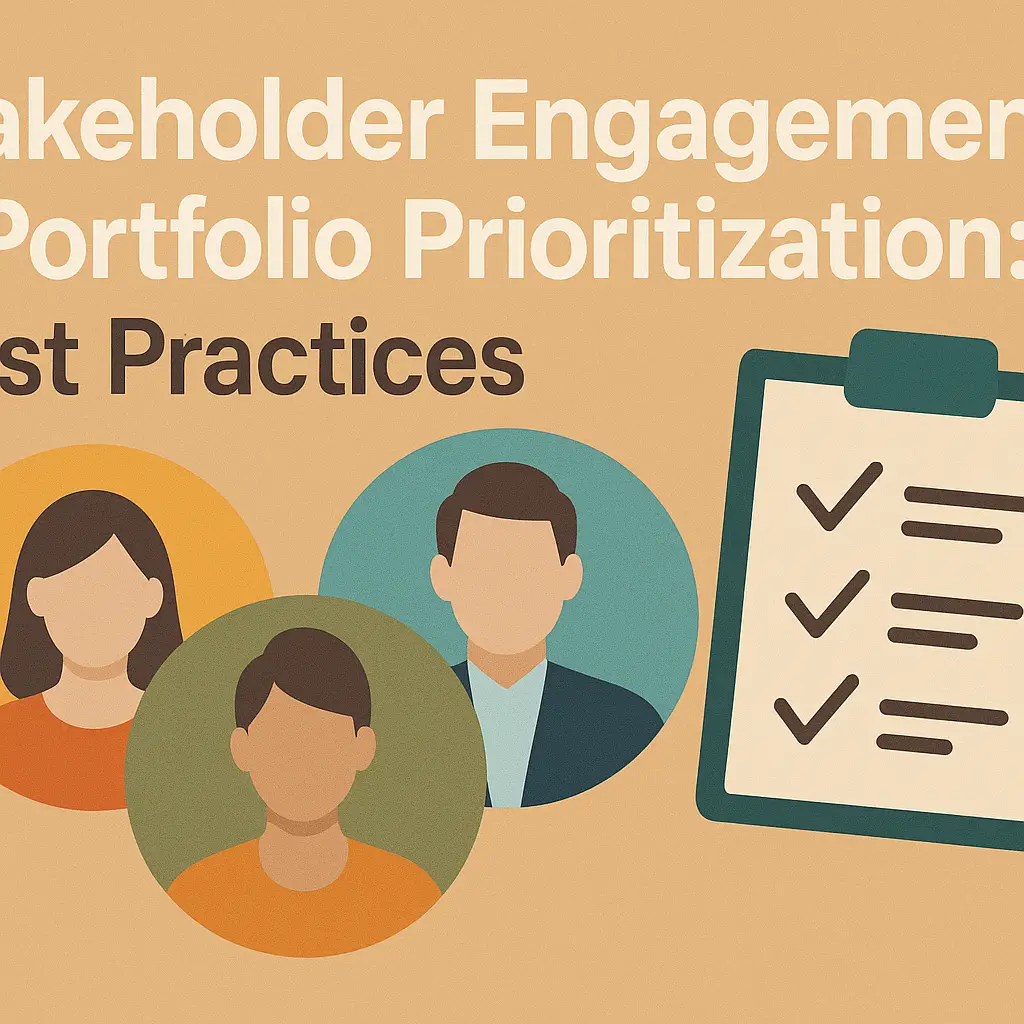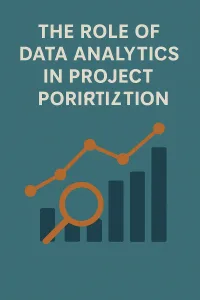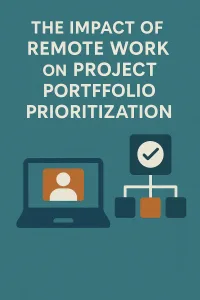Introduction to Portfolio Prioritization
Portfolio prioritization is a critical process that involves evaluating and ranking projects based on their alignment with organizational goals, resource availability, and potential return on investment. This systematic approach ensures that organizations focus their efforts on the most valuable projects, thereby maximizing their overall portfolio value.
- Definition and Role: Portfolio prioritization refers to the process of assessing and selecting projects to be undertaken within a portfolio, ensuring that resources are allocated efficiently and effectively. It plays a vital role in project management by enabling organizations to make informed decisions about which projects to pursue, based on strategic objectives and stakeholder needs [1].
- Significance of Alignment: Aligning projects with organizational strategy is paramount. When projects are in sync with the broader goals of the organization, they are more likely to contribute to overall success and sustainability. This alignment not only enhances the likelihood of achieving desired outcomes but also fosters a sense of purpose among team members and stakeholders, as they can see how their work contributes to the organization’s mission [2].
- Stakeholder Engagement: Engaging stakeholders in the prioritization process is essential for several reasons. Stakeholders bring diverse perspectives and insights that can significantly influence project selection and prioritization. By involving them, organizations can enhance transparency, foster collaboration, and increase buy-in for the chosen projects. This engagement can take various forms, such as workshops, surveys, or regular meetings, allowing stakeholders to voice their opinions and preferences, which can lead to more informed decision-making [3][4].
Effective portfolio prioritization is not just about selecting the right projects; it is also about ensuring that stakeholders are actively involved in the process. This engagement not only improves the quality of decisions made but also strengthens relationships and support for the projects that are ultimately chosen.
Understanding Stakeholders in Portfolio Management
Particularly in portfolio prioritization, understanding stakeholders is crucial for effective decision-making and project success. Stakeholders are defined as individuals, groups, or organizations that may affect, be affected by, or perceive themselves to be affected by a decision, activity, or outcome of a project, program, or portfolio [1]. Their involvement can significantly influence the prioritization process, making it essential to identify and categorize them appropriately.
Defining Stakeholders in Project Management
Stakeholders can be broadly categorized based on their relationship to the project. They include:
- Project Team Members: Individuals directly involved in executing the project.
- Management: Executives and senior management who provide strategic direction and resources.
- Clients and Customers: Those who will use the project’s deliverables or services.
- Regulatory Bodies: Organizations that impose regulations affecting the project.
- Suppliers and Contractors: External parties providing goods or services necessary for project completion.
Understanding who these stakeholders are and their roles is the first step in effective stakeholder engagement during portfolio prioritization.
Internal vs. External Stakeholders
Stakeholders can be classified into two main categories:
- Internal Stakeholders: These include individuals or groups within the organization, such as employees, management, and board members. They typically have a direct interest in the project’s success and may influence its direction through their decisions and actions.
- External Stakeholders: These are individuals or groups outside the organization, such as customers, suppliers, investors, and regulatory agencies. Their interests may vary, and they can significantly impact the project’s outcomes through their feedback, requirements, and regulations.
Recognizing the differences between internal and external stakeholders is vital for tailoring engagement strategies that address their specific needs and concerns.
Levels of Influence and Interest
Stakeholders possess varying levels of influence and interest in portfolio decisions, which can be mapped using a power/interest grid. This tool helps project managers identify:
- High Power, High Interest: These stakeholders are critical to the project’s success and should be actively engaged and managed closely.
- High Power, Low Interest: While they have significant influence, their interest may be limited. Keeping them satisfied is essential to prevent potential issues.
- Low Power, High Interest: These stakeholders are interested in the project but lack the power to influence it significantly. They should be kept informed and engaged to foster support.
- Low Power, Low Interest: These stakeholders require minimal attention but should not be ignored entirely, as their interest may change over time.
By understanding the varying levels of influence and interest, project managers can prioritize stakeholder engagement effectively, ensuring that the most critical voices are heard during the portfolio prioritization process [2][3].
Effectively involving stakeholders in portfolio prioritization requires a clear understanding of who they are, their categorization as internal or external, and their varying levels of influence and interest. By applying these insights, project managers can enhance stakeholder engagement, leading to more informed and successful project outcomes.
The Importance of Stakeholder Engagement
Particularly in portfolio prioritization, engaging stakeholders is not merely a procedural formality; it is a critical component that can significantly influence the success of projects. Here are several key points that underscore the importance of stakeholder engagement in the prioritization process:
- Enhanced Decision-Making: Involving stakeholders in the prioritization process leads to more informed and balanced decision-making. By engaging those who will be affected by the projects, organizations can gather valuable insights that reflect the needs and expectations of various groups. This collaborative approach fosters transparency and builds trust, which are essential for effective project execution [1].
- Diverse Perspectives and Expertise: Stakeholders bring a wealth of knowledge and experience to the table. Their diverse perspectives can illuminate potential challenges and opportunities that may not be apparent to project managers alone. This diversity not only enriches the decision-making process but also helps in identifying innovative solutions and strategies that can enhance project outcomes [11]. By leveraging the expertise of stakeholders, organizations can ensure that their project portfolio aligns more closely with organizational goals and stakeholder interests.
- Mitigating Risks of Inadequate Involvement: Failing to adequately involve stakeholders can lead to significant risks, including misalignment of project objectives, lack of support, and potential project failure. When stakeholders feel excluded from the decision-making process, they may become disengaged or resistant to the projects, which can hinder progress and lead to conflicts down the line [2]. Moreover, inadequate stakeholder engagement can result in missed opportunities for collaboration and resource sharing, ultimately impacting the overall success of the project portfolio.
Effective stakeholder engagement in portfolio prioritization is essential for achieving project success. By fostering collaboration, embracing diverse perspectives, and mitigating risks associated with inadequate involvement, project managers can enhance the quality of their decision-making processes and drive better outcomes for their organizations.
Best Practices for Engaging Stakeholders
Engaging stakeholders effectively in the portfolio prioritization process is crucial for project managers and stakeholder managers. Their insights and feedback can significantly influence the success of project selection and resource allocation. Here are some actionable strategies to ensure that stakeholders are actively involved:
- Identify Key Stakeholders Early: Begin by mapping out who the key stakeholders are in your project. This includes individuals or groups who may affect or be affected by the project outcomes. Early identification allows for timely engagement and ensures that their perspectives are considered from the outset, which can lead to more informed decision-making [12][15].
- Establish Clear Communication Channels: Create and maintain open lines of communication with stakeholders throughout the prioritization process. This includes setting up regular updates and feedback mechanisms that allow stakeholders to voice their opinions and concerns. A well-defined communication plan can help keep everyone informed about project progress and decisions, fostering a sense of inclusion and transparency [6][3].
- Utilize Workshops and Meetings: Organize workshops and meetings specifically designed to gather insights from stakeholders. These collaborative sessions can serve as platforms for brainstorming, discussing priorities, and addressing any potential conflicts. Engaging stakeholders in this manner not only enhances collaboration but also helps in building consensus around project priorities [4][8].
- Implement Structured Prioritization Frameworks: Use established prioritization frameworks such as MoSCoW (Must have, Should have, Could have, and Won’t have) or Weighted Scoring. These frameworks can help in systematically evaluating projects based on stakeholder input, ensuring that their voices are reflected in the prioritization process. By involving stakeholders in these structured methodologies, you can achieve a more balanced and objective assessment of project value [1][12].
By following these best practices, project managers can enhance stakeholder engagement in the portfolio prioritization process, leading to more effective project selection and improved overall project outcomes.
Tools and Techniques for Stakeholder Engagement
Effective stakeholder engagement is crucial for successful portfolio prioritization. By actively involving stakeholders in the decision-making process, project managers can enhance transparency, foster collaboration, and secure buy-in for the selected projects. Here are some essential tools and techniques that can facilitate stakeholder involvement in portfolio prioritization:
Digital Tools for Engagement
- Project Management Software: Utilizing platforms like Asana, Trello, or Microsoft Project can streamline communication and task management. These tools allow stakeholders to track project progress, provide feedback, and collaborate in real-time, ensuring that everyone is aligned with the project goals and priorities.
- Collaboration Platforms: Tools such as Slack or Microsoft Teams enable ongoing dialogue among stakeholders. These platforms support file sharing, discussions, and updates, making it easier to keep stakeholders informed and engaged throughout the prioritization process.
- Survey Tools: Online survey tools like SurveyMonkey or Google Forms can be employed to gather stakeholder opinions and preferences regarding project priorities. This method allows for anonymous feedback, which can lead to more honest and constructive input.
Engagement Techniques
- Surveys: Conducting surveys is an effective way to gauge stakeholder priorities and preferences. By asking targeted questions, project managers can collect quantitative data that reflects stakeholder sentiments, which can then inform the prioritization process [1].
- Focus Groups: Organizing focus group discussions with key stakeholders can provide deeper insights into their perspectives. This technique encourages open dialogue and allows stakeholders to express their views on project priorities, fostering a sense of ownership and collaboration [1].
- Brainstorming Sessions: Facilitating brainstorming sessions can generate innovative ideas and solutions. By bringing together diverse stakeholders, project managers can harness collective knowledge and creativity, leading to a more comprehensive understanding of project priorities [1].
Visual Aids for Communication
- Charts and Graphs: Visual aids such as charts and graphs can effectively communicate project priorities and stakeholder feedback. By presenting data visually, project managers can simplify complex information, making it easier for stakeholders to understand and engage with the prioritization process [1].
- Power/Interest Grids: Utilizing a power/interest grid can help project managers identify and categorize stakeholders based on their influence and interest in the project. This visual tool aids in prioritizing engagement efforts, ensuring that the most critical stakeholders receive the attention they need [1].
- Project Roadmaps: Creating a visual project roadmap can provide stakeholders with a clear overview of project timelines, milestones, and priorities. This tool not only enhances transparency but also helps stakeholders visualize their role in the project’s success [1].
By leveraging these tools and techniques, project managers can effectively engage stakeholders in the portfolio prioritization process. This engagement not only enhances the quality of decision-making but also fosters a collaborative environment where stakeholders feel valued and invested in the project’s outcomes.
Measuring Stakeholder Engagement Effectiveness
Particularly during the portfolio prioritization process, effective stakeholder engagement is crucial. It not only ensures that the right projects are prioritized but also fosters a sense of ownership and commitment among stakeholders. To assess the impact of stakeholder engagement on the prioritization process, project managers can implement several best practices.
Define Metrics to Evaluate Stakeholder Engagement
Establishing clear metrics is essential for evaluating the effectiveness of stakeholder engagement. Some key metrics to consider include:
- Participation Rates: Track the number of stakeholders involved in the prioritization discussions and decision-making processes. High participation rates can indicate strong engagement and interest in the projects being prioritized [2].
- Feedback Quality: Assess the depth and relevance of the feedback provided by stakeholders. This can be measured through qualitative analysis of comments and suggestions, as well as quantitative ratings on feedback forms [4].
- Sentiment Analysis: Utilize tools to analyze the sentiment of stakeholder feedback, which can provide insights into their overall satisfaction and concerns regarding the prioritization process [4].
Gathering and Analyzing Stakeholder Feedback Post-Prioritization
Once the prioritization process is complete, it is vital to gather and analyze stakeholder feedback to understand their perspectives and experiences. This can be achieved through:
- Surveys and Questionnaires: Distribute surveys to stakeholders to collect their thoughts on the prioritization process, including what worked well and what could be improved. This feedback can be invaluable for future prioritization efforts [5].
- Focus Groups: Conduct focus group discussions with a diverse set of stakeholders to delve deeper into their experiences and gather qualitative insights. This method allows for a richer understanding of stakeholder sentiments and suggestions [5].
- Regular Check-Ins: Establish a routine for follow-up meetings or check-ins with stakeholders to discuss their ongoing concerns and gather feedback on the prioritization outcomes. This continuous dialogue can help maintain engagement and address any issues promptly [6].
Importance of Continuous Improvement Based on Lessons Learned
The process of stakeholder engagement in portfolio prioritization should not be static. It is essential to embrace a culture of continuous improvement by:
- Documenting Lessons Learned: After each prioritization cycle, document the lessons learned regarding stakeholder engagement. This documentation should include what strategies were effective, what challenges were faced, and how stakeholder feedback influenced the outcomes [11].
- Adapting Strategies: Use the insights gained from stakeholder feedback to adapt and refine engagement strategies for future prioritization efforts. This iterative approach ensures that the process evolves to meet the needs of stakeholders and the organization [11].
- Fostering a Feedback Loop: Create a feedback loop where stakeholders are informed about how their input has been utilized in the prioritization process. This transparency not only builds trust but also encourages ongoing participation in future initiatives [7].
By implementing these methods, project managers can effectively measure and enhance stakeholder engagement during the portfolio prioritization process, ultimately leading to more informed decision-making and successful project outcomes.
Case Studies: Successful Stakeholder Engagement in Portfolio Prioritization
Effective stakeholder engagement is crucial for successful portfolio prioritization. By involving stakeholders in the decision-making process, organizations can enhance transparency, foster collaboration, and ultimately achieve better project outcomes. Below are case studies from successful organizations that exemplify best practices in stakeholder engagement during portfolio prioritization.
Case Study 1: Tech Innovations Inc.
Background: Tech Innovations Inc., a leading software development company, faced challenges in prioritizing its project portfolio due to diverse stakeholder interests.
Strategies Employed:
– Stakeholder Mapping: The organization utilized a power/interest grid to categorize stakeholders based on their influence and interest levels. This helped identify key stakeholders who needed to be engaged in the prioritization process [5].
– Regular Workshops: Tech Innovations organized regular workshops that included stakeholders from various departments. These workshops facilitated open discussions about project objectives and stakeholder needs, ensuring that all voices were heard [2].
Outcomes Achieved:
– The company successfully aligned its project portfolio with stakeholder expectations, resulting in a 30% increase in project success rates.
– Enhanced collaboration led to improved communication flows, reducing project delays by 20% [11].
Lessons Learned:
– Engaging stakeholders early in the process is vital for understanding their needs and expectations.
– Regular communication and feedback loops can significantly improve stakeholder buy-in and support for prioritized projects.
Case Study 2: Green Energy Solutions
Background: Green Energy Solutions, a renewable energy firm, aimed to prioritize projects that aligned with both business goals and community interests.
Strategies Employed:
– Community Engagement Sessions: The organization held community engagement sessions to gather input from local stakeholders, including residents and environmental groups. This approach ensured that community concerns were addressed in the project selection process [2].
– Transparent Decision-Making: Green Energy Solutions implemented a transparent decision-making framework that allowed stakeholders to see how their input influenced project prioritization. This transparency fostered trust and collaboration [3].
Outcomes Achieved:
– The firm successfully prioritized projects that not only met business objectives but also garnered community support, leading to a 40% increase in project approvals from local authorities.
– Stakeholder satisfaction improved significantly, with positive feedback from community members regarding the firm’s commitment to addressing their concerns [4].
Lessons Learned:
– Involving community stakeholders can lead to more sustainable project outcomes and enhance the organization’s reputation.
– Transparency in decision-making processes is essential for building trust and ensuring stakeholder engagement.
Case Study 3: Global Manufacturing Corp.
Background: Global Manufacturing Corp. was struggling with project prioritization due to competing interests from various departments.
Strategies Employed:
– Cross-Departmental Committees: The organization established cross-departmental committees that included representatives from finance, operations, and marketing. This ensured that diverse perspectives were considered during the prioritization process [1].
– Data-Driven Decision Making: By utilizing data analytics, the committees assessed project viability based on key performance indicators (KPIs) and objectives, allowing for informed prioritization decisions [7].
Outcomes Achieved:
– The company improved its project alignment with strategic goals, resulting in a 25% increase in overall project efficiency.
– The collaborative approach reduced conflicts between departments, leading to a more cohesive organizational strategy [11].
Lessons Learned:
– Cross-departmental collaboration is essential for understanding the broader impact of project prioritization.
– Data-driven decision-making can enhance the effectiveness of stakeholder engagement by providing objective criteria for project selection.
Conclusion
The significance of stakeholder engagement in portfolio prioritization cannot be overstated. Engaging stakeholders not only enhances transparency but also fosters collaboration and increases buy-in for the selected projects. By involving stakeholders in the decision-making process, organizations can ensure that the chosen portfolio aligns with the expectations and needs of those affected, ultimately leading to greater project success [1][11].
As project managers and stakeholder managers, it is crucial to regularly assess your current engagement practices. Consider how effectively you are identifying and prioritizing stakeholders, and whether you are communicating with them transparently and regularly. This self-assessment can reveal areas for improvement and help you align your portfolio management strategies with stakeholder expectations [2][9][15].
Start by mapping your stakeholders, understanding their power and interest levels, and maintaining open lines of communication. By doing so, you can enhance your stakeholder engagement efforts and drive better outcomes for your projects [6][8][15].
Find out more about Shaun Stoltz https://www.shaunstoltz.com/about/.
This post was written by an AI and reviewed/edited by a human.



